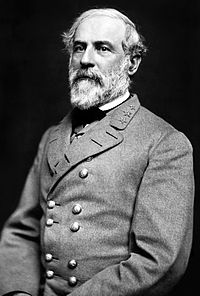Today in 1865, with the end in sight, the final campaign of the Civil War begins in Virginia when Union troops under General Ulysses S. Grant begin to move against the Confederate trenches built around

Petersburg. General Robert E. Lee’s outnumbered Rebels were soon forced to evacuate the city and

begin a desperate race to escape to the west.
Eleven months earlier, Grant had moved his army across the Rapidan River in northern Virginia and began the bloodiest campaign of the war. For six weeks, Lee and Grant fought along an arc that swung east of the Confederate capital at Richmond. They engaged in some of the conflict’s bloodiest battles at Wilderness, Spotsylvania, and Cold Harbor before settling into trenches for a siege of Petersburg, 25 miles south of Richmond. The fighting in the Wilderness and at Cold Harbor had earned Grant the uneviable nickname of “Butcher” as a result of the heavy casualties. Years later, Grant said that fight was a mistake. The trenches eventually stretched all the way to Richmond, and during the ensuing months the armies glowered at each other across a no man’s land. From time to time, Grant would launch attacks against sections of the Rebel defenses, but Lee’s men always managed to fend them off.
Time was running out for Lee, though, and he knew it. His army was dwindling in size to about 55,000, due to illness, soldiers not coming back from leave, and even mass desertions as the men could see the handwriting on the wall. On the other side of the trenches, Grant’s army continued to grow–the Army of the Potomac now had more than 125,000 men ready for service. On March 25, Lee attempted to split the Union lines when he attacked Fort Stedman, a stronghold along the Yankee trenches. His army was beaten back, and he lost nearly 5,000 men. On March 29, Grant seized the initiative, sending 12,000 men past the Confederates’ left flank and threatening to cut Lee’s escape route from Petersburg. Fight-ing broke out there, several miles southwest of the city. Lee’s men simply were not enought, in number or strength, to stop the Federal advance. On April 1, the Yankees struck at Five Forks, soundly defeat-ing the Rebels and leaving Lee no viable alternative. He pulled his forces from their trenches and raced west, followed by Grant. It was a race that even the great Lee could not win. Upon learning there were boxcars on a railroad siding that held the rations his men so desperately needed to go on, he fled to Danville. When he got there, the boxcars were there as well, but due to a mixup of instructions in the war Department, all they held was ammunition. Lee knew it was over, and there was no reason to sacrifice his men any further. He surrendered his army on April 9, 1865, at Appomattox Court House.
To purchase a signed copy of Larry Auerbach’s novel “The Spirit Of Redd Mountain”, Click Here
Photo courtesy of wikipedia.com

